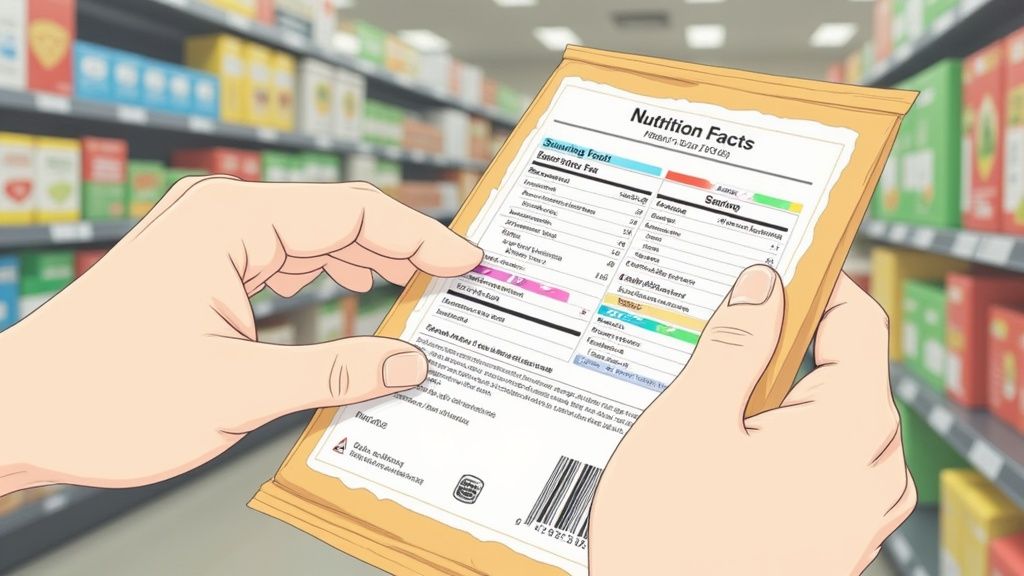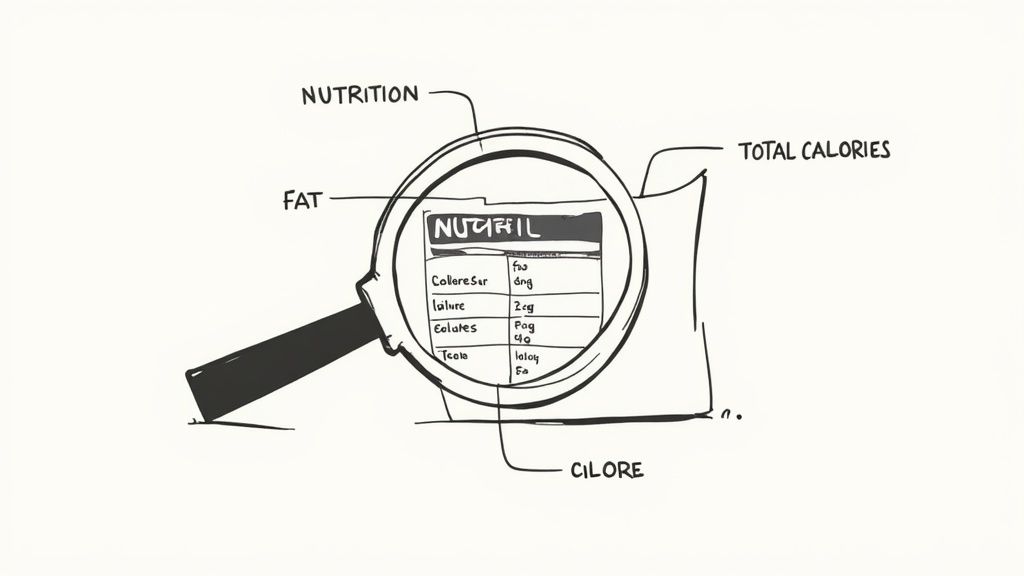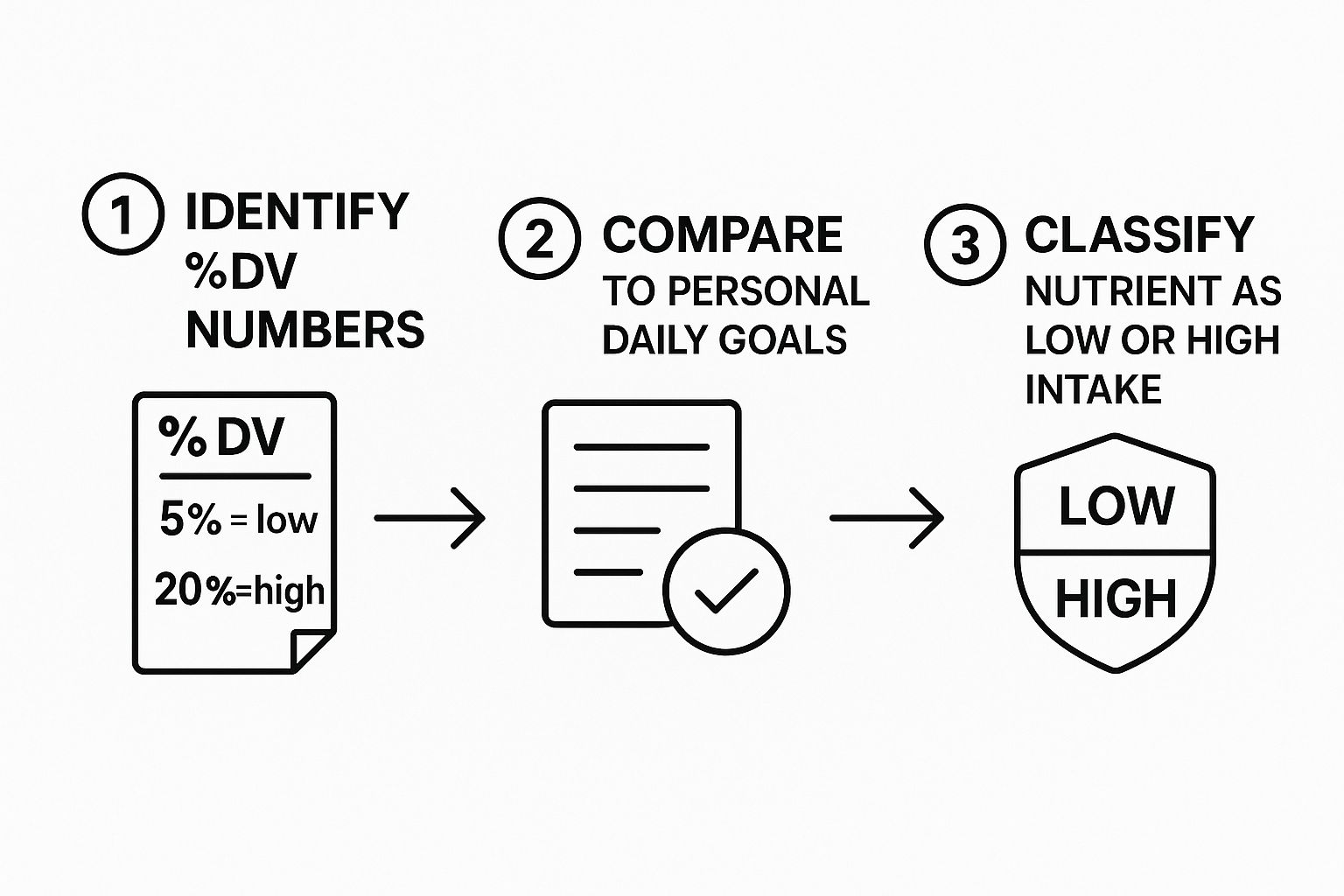How to Read Nutrition Labels: A Simple Guide

Let's be honest, staring at a nutrition label can feel like you're trying to decipher a secret code. All those numbers, percentages, and tiny print can be overwhelming. But here's the good news: you don't need to analyze every single line to make a smart choice.
The secret is knowing where to look first. Once you master a quick-scan method, you can size up any product in seconds. It’s a skill that puts you in control of your food choices, which is more important than ever. In fact, a recent survey found that nearly 80% of U.S. adults now regularly check the Nutrition Facts panel, a big jump from just 62% in the mid-2000s. You can dig into more of these fascinating consumer food label trends from the University of Minnesota.
So, how do you join the ranks of these savvy shoppers? Forget the information overload and focus on just three key areas.
Your 3-Point Label Check
Think of this as your mental checklist for every grocery run. It’s a simple system to help you cut through the marketing fluff and get straight to the facts. This quick reference table breaks down what you need to check for a fast, effective assessment.
| Check Point | What It Tells You | Why It's Important |
|---|---|---|
| Serving Size | The amount of food the label's numbers apply to. | This is the foundation. All other values (calories, sugar, fat) are based on this portion. It’s often much smaller than what people actually eat. |
| Calories | The total energy you'll get from one serving. | A key piece of information for managing your energy intake and weight, but it doesn't tell you about nutrient quality. |
| % Daily Value (%DV) | How much a nutrient in one serving contributes to your total daily diet. | This is your shortcut to see if a food is high or low in nutrients like fiber, sodium, or vitamins. 5% DV or less is low; 20% DV or more is high. |
By focusing on these three things, you get the most important information right away. You can quickly compare two different brands of yogurt or cereal and see which one better fits your health goals.
Pro Tip: Always, always start with the serving size. It’s the most common mistake people make. If the serving size is 1 cup but you know you’ll eat 2, you have to double everything else on that label—the calories, the sugar, the sodium. Nailing this one step changes everything.
Mastering Serving Size and Calorie Count
Let’s start with the single most important—and frankly, most misleading—part of any nutrition label: the serving size. This is the first place you should look, because every other number on that panel, from calories to sugar, is based on it. It’s also where most people get tripped up.

Food companies have a knack for choosing serving sizes that are much smaller than what a person would actually eat in one sitting. You might see a small bag of chips that boasts "150 calories" on the front. But when you flip it over, you discover the serving size is just 11 chips, and the bag actually contains three servings. Tricky, right?
This disconnect between the label and reality is a huge reason why people struggle to manage what they eat. It's a worldwide issue, too. Research shows that many consumers only partially understand these labels. A 2018 study even found that 61.8% of participants didn't use nutritional information to guide their food choices, which just goes to show how vital this skill is. You can read more about these global consumer challenges with nutrition labels on PMC.
Connecting Servings to Your Reality
To get a real sense of what you're about to eat, you have to compare the listed serving size to the portion you're actually going to have. This takes a little bit of honest math.
Let’s run through some common examples you've probably encountered:
- A pint of ice cream: The label might list a serving as 2/3 of a cup, but the whole container has four servings. If you polish off half the pint (we've all been there), you've just had two full servings.
- A 20-ounce bottle of soda: This is almost always considered 2.5 servings. If you drink the entire bottle, you need to multiply all the numbers on the label—calories, sugar, everything—by 2.5.
Key Takeaway: Before your eyes even drift to the calorie count, find the “Servings Per Container” at the top of the label. Think of this number as your personal multiplier.
If a single serving is 200 calories and the package contains three servings, finishing the whole thing means you've consumed 600 calories, not 200. This basic multiplication is the absolute foundation of reading a nutrition label correctly. Get this part wrong, and the rest of the information is pretty much useless.
Once you make a habit of this, you’ll build the awareness you need to make genuinely informed choices at the grocery store.
Looking Beyond Calories at the Nutrients

Alright, you've got the serving size and calories figured out. Now, let's get to the real story: the quality of those calories. This means looking at the macronutrients—fat, carbohydrates, and protein. These are what give your body energy and keep things running smoothly.
But not all macros are created equal. Think of this part of the label as a detective's clue file. It helps you move from just knowing how much energy you're getting to understanding what kind of energy it is.
Understanding Fats and Carbs
This is where the most revealing information is hiding. The label splits fats and carbs into smaller categories, and you'll want to pay close attention here.
When you look at fat, your eyes should immediately scan for Saturated Fat and, more importantly, Trans Fat. A little saturated fat is generally fine, but trans fats are the ones you really want to avoid entirely due to their strong links to poor health outcomes.
The carbohydrate section tells a similar tale. The "Total Carbohydrates" figure is just the headline. The important details are a few lines down:
- Dietary Fiber: This is your friend. Fiber is a beneficial carb that helps with digestion and keeps you feeling full longer. Generally, the more, the better.
- Total Sugars: This number lumps together all sugars—the natural ones found in fruit or milk and the ones added during manufacturing.
- Added Sugars: This is the big one. If you're trying to eat healthier, this line is your best friend. It shows you exactly how much sugar, like cane sugar or high-fructose corn syrup, was dumped into the product during processing.
Be wary of foods marketed as "healthy" or "low-fat." I've seen countless fat-free yogurts where the flavor is just replaced with a mountain of sugar. It might have 15 grams of added sugar per serving, making it far less healthy than the plain, full-fat version.
Learning to spot these trade-offs is a game-changer. It's amazing where you'll find hidden sugar in foods once you start looking. Keeping that added sugar number low is one of the single best things you can do for your diet.
Key Micronutrients to Watch
Beyond the "big three" macros, the updated nutrition label also shines a spotlight on a few micronutrients (vitamins and minerals) that many of us are lacking.
The ones to keep an eye on are:
- Sodium: We need it, but most of us get way too much, especially from packaged and processed foods. A simple trick I use is to check if the sodium in milligrams (mg) is lower than the number of calories. If it is, you're usually in a good spot.
- Vitamin D & Potassium: These were specifically added to the new label because they are "nutrients of public health concern"—meaning most people don't get enough. Choosing foods with a higher percentage of these can help you shore up your intake.
Focusing on these specific nutrients helps you shift from simply counting calories to understanding the actual nutritional value you're getting from your food.
Using Percent Daily Value for Smart Comparisons
Ever feel overwhelmed by all the numbers on a nutrition label? There’s a shortcut hiding in plain sight: the Percent Daily Value (%DV) column on the far right.
Think of the %DV less as a rigid set of rules and more as a quick reference guide. It’s designed to help you see, at a glance, whether a food is high or low in a particular nutrient, making those in-aisle decisions so much easier.
It’s a fantastic tool, yet it's surprisingly underused. A recent study revealed that only about 40.4% of people regularly check nutrition labels on prepackaged foods. This number fluctuates a lot worldwide, but it points to a huge opportunity for shoppers to make more informed choices. You can dive deeper into the full study on global nutrition label usage if you're curious.
The 5/20 Rule for Quick Decisions
To make things even simpler, I always teach people the 5/20 Rule. It’s a brilliant mental shortcut that helps you quickly scan any label, no math required.
Here's how it works:
- 5% DV or less is considered low for any given nutrient. This is your target for things you want to limit, like added sugars, sodium, and saturated fat.
- 20% DV or more is considered high. Look for this when you want more of the good stuff, like fiber, vitamin D, potassium, and calcium.
This simple framework helps you instantly size up a product.

Let's put this into a real-world scenario.
Imagine you're standing in the cereal aisle, comparing two boxes. Cereal A has 25% DV of added sugars but only 4% DV of sodium. Right next to it, Cereal B has just 5% DV of added sugars but 8% DV of sodium. If your goal is to cut back on sugar, the 5/20 rule makes the choice obvious—Cereal B is the clear winner. This kind of quick check takes seconds and can make a huge difference in your diet.
How to Decode the Ingredient List

While the nutrition facts give you the numbers, the ingredient list is where the real story unfolds. This is your chance to look past the marketing claims on the front of the box and see what you're really eating. Think of it as your secret weapon.
There's one golden rule here: ingredients are listed by weight, from most to least. The first three to five ingredients make up the bulk of the product. If you see sugar, some kind of processed oil, or an unpronounceable chemical near the top, that's a pretty clear sign to put it back.
Spotting Hidden Sugars and Additives
Food companies have gotten incredibly clever at hiding sugar. They use dozens of different names, which keeps "sugar" from appearing as the first ingredient. A product might seem low in sugar on the surface, but once you add up all the different sweeteners sprinkled throughout the list, the reality is often quite different.
Key Takeaway: Listing multiple types of sweeteners is a common trick to disguise the total sugar content. Seeing "organic cane juice," "dextrose," and "barley malt" listed separately prevents "sugar" from being the #1 ingredient.
Here are just a few of the common names for sugar to keep on your radar:
- Syrups: High-fructose corn syrup, brown rice syrup, maple syrup
- Words ending in "-ose": Sucrose, dextrose, fructose, maltose
- So-called "natural" sugars: Agave nectar, honey, molasses, fruit juice concentrate
Getting good at spotting these is a game-changer. For more on this, check out our guide with practical tips for cutting out sugar.
The same principle applies to grains. Don't let terms like "multigrain" or "made with whole grains" fool you. You want to see the word "whole" right at the beginning, like "whole wheat flour" or "whole oats." If it just says "wheat flour," it's almost certainly a refined grain stripped of its best nutrients.
Finally, a good rule of thumb is to be wary of long ingredient lists. If it reads like a science project, it’s a highly processed food. Sticking to products with short lists of ingredients you actually recognize is one of the simplest and most powerful changes you can make.
Still Have Questions About Food Labels?
Even when you feel like you've mastered reading nutrition labels, certain questions always seem to pop up in the middle of the grocery aisle. It happens to all of us. Let's walk through some of the most common points of confusion and get you some clear, straightforward answers.
What’s the Difference Between Total and Added Sugars?
This one is a big deal. Total Sugars on the label counts every bit of sugar in the product. This includes sugars that are naturally there, like fructose from fruit or lactose from milk, as well as any sugars that were tossed in during manufacturing.
Added Sugars, on the other hand, zeroes in on only the sweeteners put in for flavor—think cane sugar, high-fructose corn syrup, or honey. If you're focused on a healthier diet, your main goal should be keeping that Added Sugars number as close to zero as possible. This can be tough, and if you find it a real struggle, you might find it helpful to learn how to overcome sugar addiction with practical, real-world strategies.
Does "Fat-Free" Mean It's Healthy?
Absolutely not. This is probably one of the most common and misleading health traps out there. When companies strip the fat out of a food, they have to replace that flavor and texture with something else. Usually, that something is a heap of extra sugar, refined starches, or sodium.
Always flip the package over and scan the full nutrition panel and the ingredient list. You'll often find that the full-fat version, with its simpler and more recognizable ingredients, is the far better—and more satisfying—choice.
Is %DV Even Useful If I Don’t Eat 2,000 Calories a Day?
Yes, it's incredibly useful! The trick is to stop thinking of the % Daily Value (%DV) as a strict rule for your specific diet. Instead, think of it as a quick-glance gauge.
Its real value comes from the 5/20 Rule: If a nutrient has 5% DV or less, it’s considered low. If it has 20% DV or more, it’s considered high.
This simple benchmark works no matter how many calories you eat. It lets you instantly see if a food is packed with something you want to limit (like saturated fat or sodium) or if it's a good source of something you need more of (like fiber or calcium).